
REVIEW
Octa Mousse Insert Review
Octa Mousse looked too good to be true when I saw the specs. They appeared to be lighter than most other inserts while having enough volume to take up much of the void inside the tire. I'd seen other inserts with this approach but I had only tried those that fill the rim bed and extend up to press against the sidewall of the tire leaving more than half the tire available to fill with air, and Tannus tubed which line the entire inside of the tire but have a conventional tube inside.
Octa Mousse is aptly named because it is shaped like an 8 sided pool noodle made of foam, and foam translates to mousse in French and Spanish. The 8 surfaces alternate between wide and narrow and the idea is to place them inside the tires so that the narrow surfaces face the rim bed, both sidewalls and the rolling surface of the tire, while the wider surfaces are meant to span the gaps between those locations.
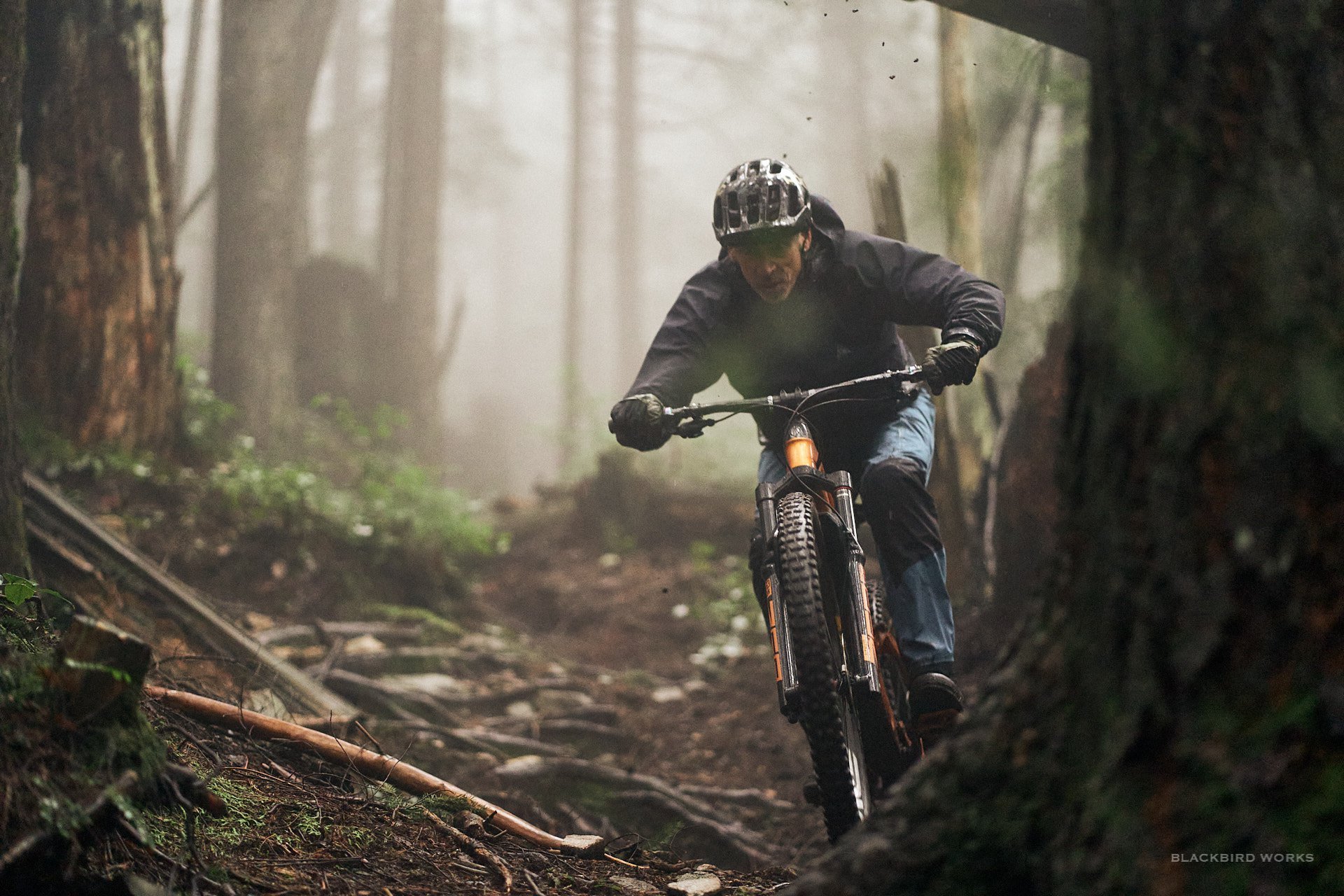
I rode Octa Mousse inserts on three bikes and three different sets of 29" wheels. Here they were mounted on ENVE M630 rims and the Trek Slash. Photo - Deniz Merdano
Octa Mousse inserts, unlike some other similar products, are shipped in their final circular form, rather than needing to be glued together by the user. Picking up one of the smaller models, the Octa 45 for example, which is designed to fit 2.2 to 2.4" tires, is a little shocking because they weigh only 110 grams in 29" size. To give you some perspective, most conventional 29er tubes weigh 250 grams or more. There is a firmer version in the same size which weighs closer to 150 grams. There is also an Octa 50 in both kinds of foam, for 2.5 or 2.6" tires and an Octa 55 for plus tires, at 2.8 to 3.0". In most cases the harder charcoal versions are recommended for enduro or e-bike use while the lighter red versions are recommended for XC to enduro use in the Octa 45 size and for enduro, e-bike, or DH in the Octa 50 size. Confused yet?
Originally I was sent a pair of Octa 45 reds and one in charcoal. First I tried the two reds together and then I put the charcoal in the rear after a bit of time. Before I began riding Octa Mousse I had an expectation of limited sidewall support, based on inserts I'd tried with good support, like Tannus and CushCore, and Rimpact which had less. Octa Mousse is shaped a lot like two Rimpacts put together and the shape doesn't allow the foam to press firmly against the base of the sidewall like both CushCore and Tannus, which are shaped more like a champagne glass.
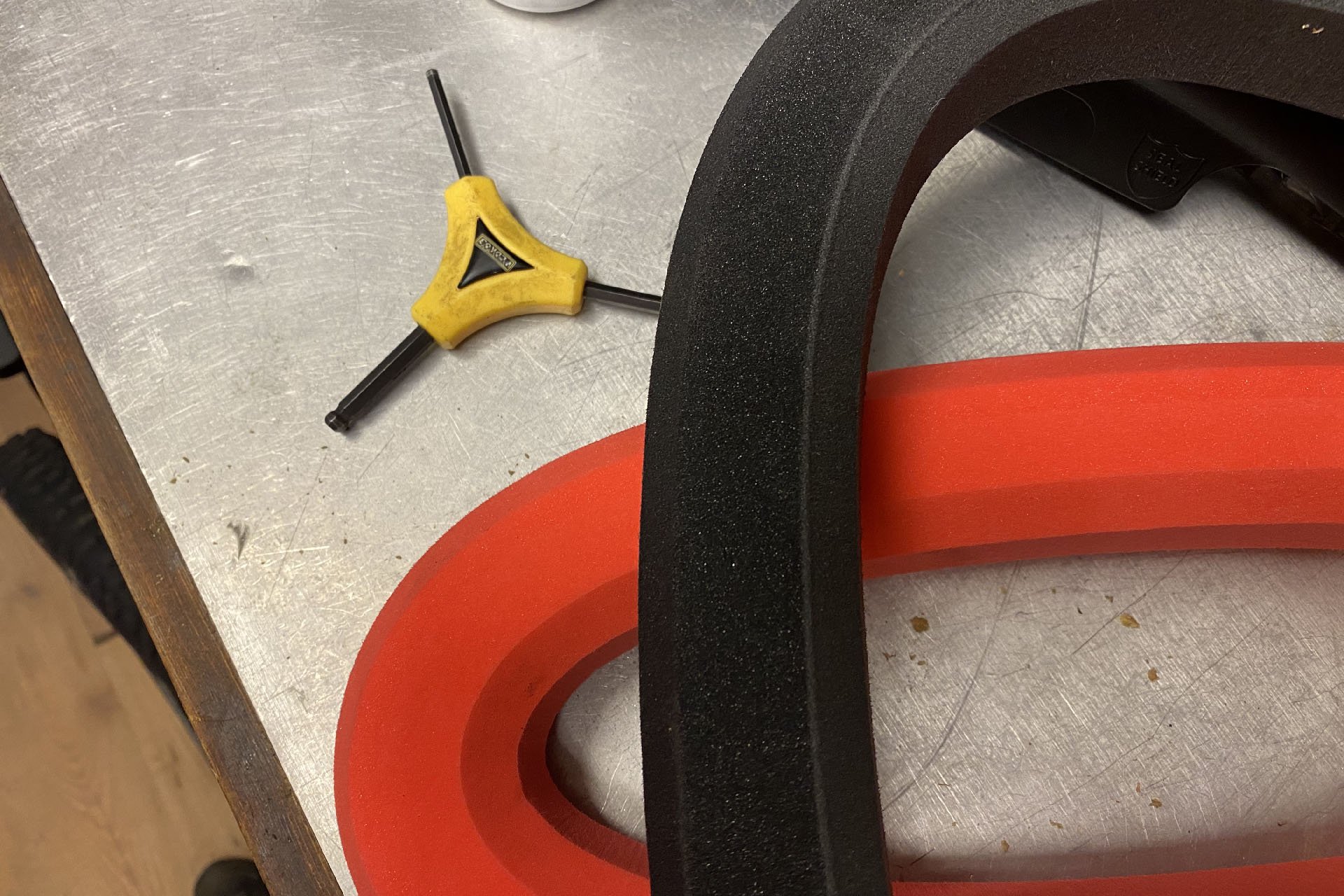
For scale. I believe these are Octa Mousse 50s, in the softer and lighter red compound and the somewhat heavier and more robust charcoal version.
Installation was relatively straightforward with one exception. The procedure involves installing one side of your tire and then inserting the Octa Mousse all the way around the tire. This is where it gets tricky. You might find the insert wants to sit in the rim bed on the wider face rather than the narrower one that Octa Mousse recommends. Twisting the insert to align it this way once it's in the tire is harder than it sounds and I often found that part of the foam was properly lined up while a final portion resisted the twist to the diamond orientation. Another challenge was that I was sometimes unsure if the final push to get the second side of the tire installed had misaligned the foam. I never noticed any difference when riding but there was one time when I removed an Octa 45 and it seemed to have the wide side against the rim.
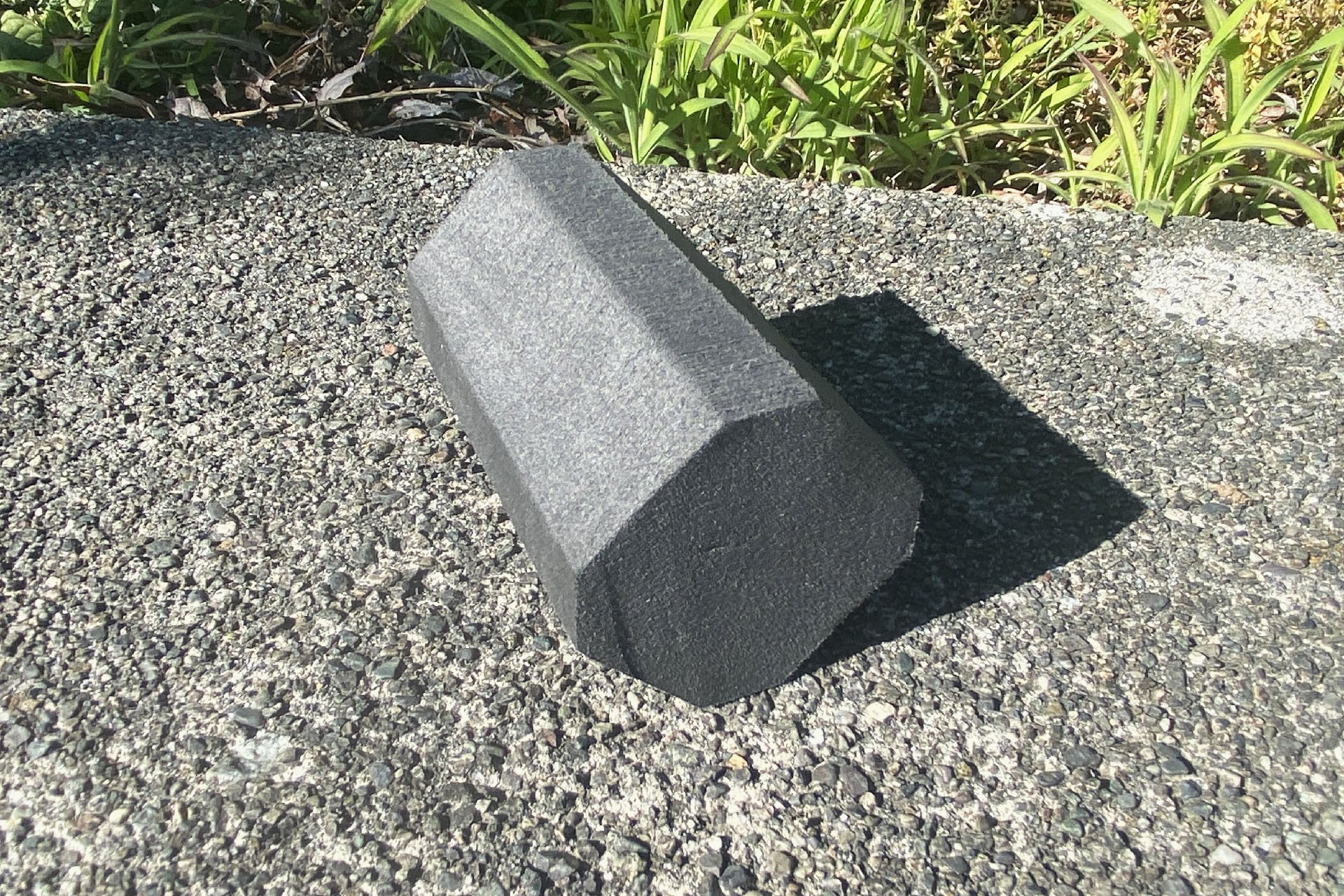
The charcoal cutaway on its own. I hope to see a more complex, sidewall-hugging shape in a material similar to this in the near future.
The volume of air required to pump up a tire with Octa Mousse inside is tiny, meaning the pressure will ramp up very quickly on impact. For most days. I settled on 16 psi front and 18 rear. I would go a little firmer or softer depending on the conditions and the terrain but I didn't veer dramatically from those numbers.
The first thing I noticed is that the feel of Octa Mousse is very different from the others I've tried. Unlike the grippy, almost spongy feeling the damping of Tannus or Cushcore provides at at low pressures, Octa Mousse feels quite firm. Because of the low pressure, there is additional grip but the sensation is much less damped. I would liken it to a fork that is very supple off the top but then gets more supportive more quickly than you are accustomed to at the beginning of the mid stroke. This will be a positive for riders who dislike the damped feeling of other inserts, and although I enjoy that sensation, I also appreciated the more immediate and firm trail feel of Octa Mousse. In that respect I wouldn't call it better or worse, but it is undeniably different. For very challenging winter conditions with plentiful slick rocks and roots, Tannus or CushCore are likely a better choice, but I was able to ride Octa Mousse in those situations capably as well.
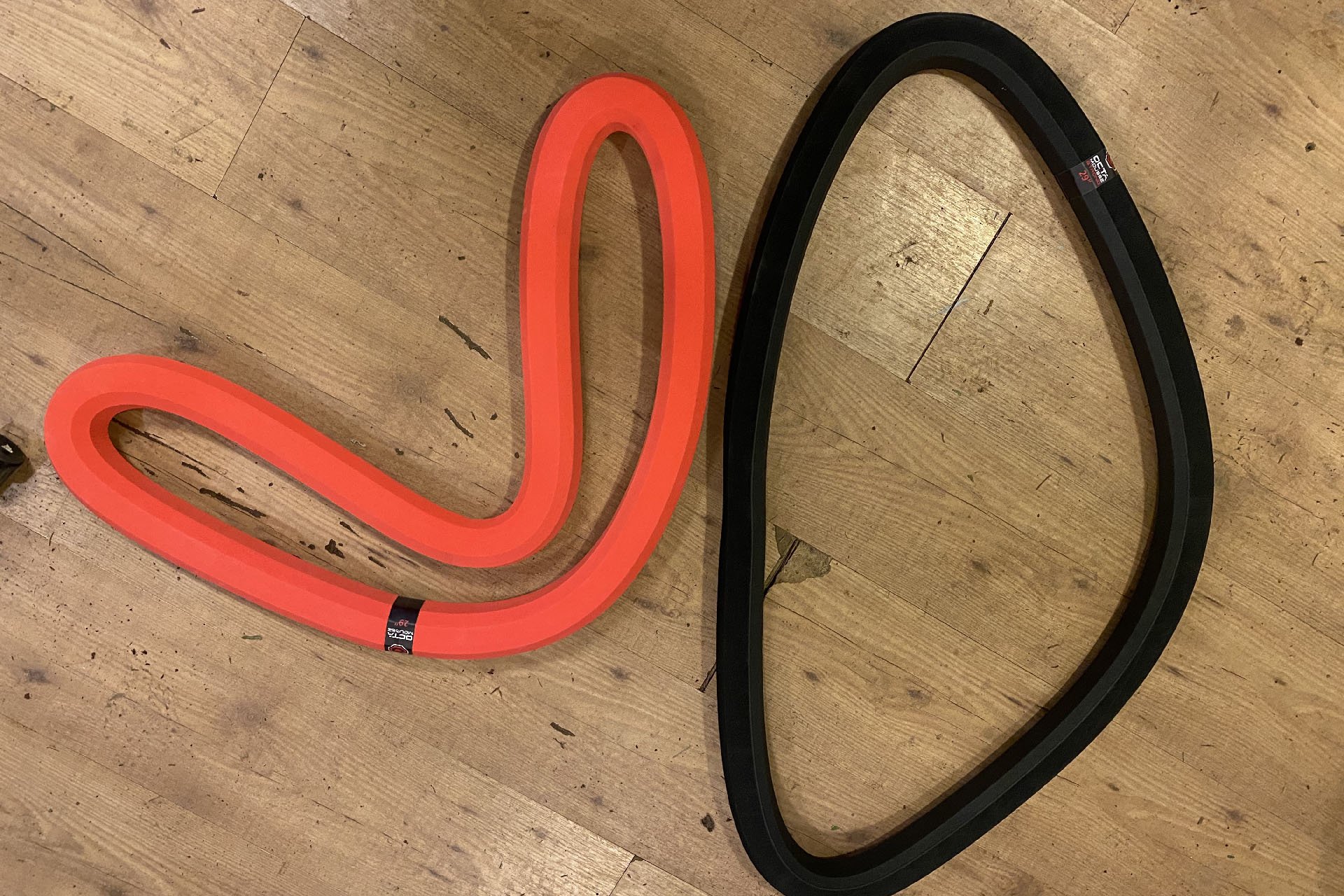
Octa Mousse comes out of the box a little pretzel-shaped but they are easily manipulated into their final form.
I was surprised to discover very capable cornering support at low pressures with Octa Mousse. It's not as firm and confidence inspiring as Tannus or CushCore, but certainly better than Rimpact. My guess is that the large volume, while not directly supporting the sidewall under pressure during a hard corner, the entire carcass is supported which prevents the tire from deforming under pressure. As I'll explain below, I discovered that, like Tannus, a certain amount of tire pressure is required to keep those side knobs biting, while CushCore does okay without any pressure at all.
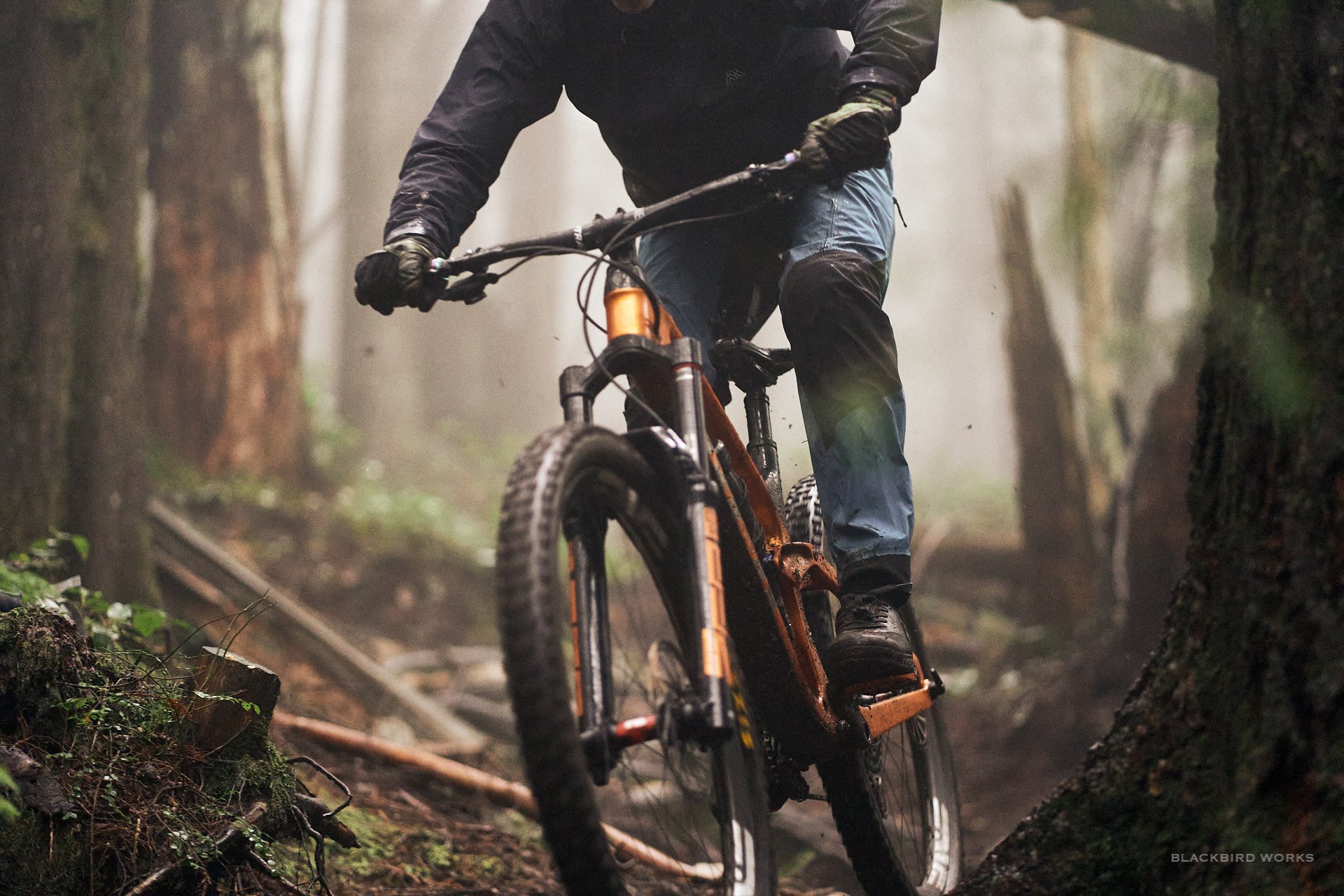
These inserts took a lot of punishment, with very few complaints.
I had an AHA! moment during the final stages of testing a set of ENVE M630 rims recently, but it was similarly illuminating for Octamousse. I messed up my speed and pop going into a step down on Cypress and cased hard and loudly. So much so that I assumed I had destroyed the rim. There was another gap coming up fast and I had about two seconds to decide whether to send it. Because I couldn't hear spokes pinging out and my rear wheel seemed to be turning fine, I went for it. I made the same decision on the next one and although there is no definite gap, I didn't send it far enough and landed on the uphill and hard. The last of the four pack was an easy one and it went fine. My buddy had stopped before the next move, a step-down off a rock, and I assessed the damage.
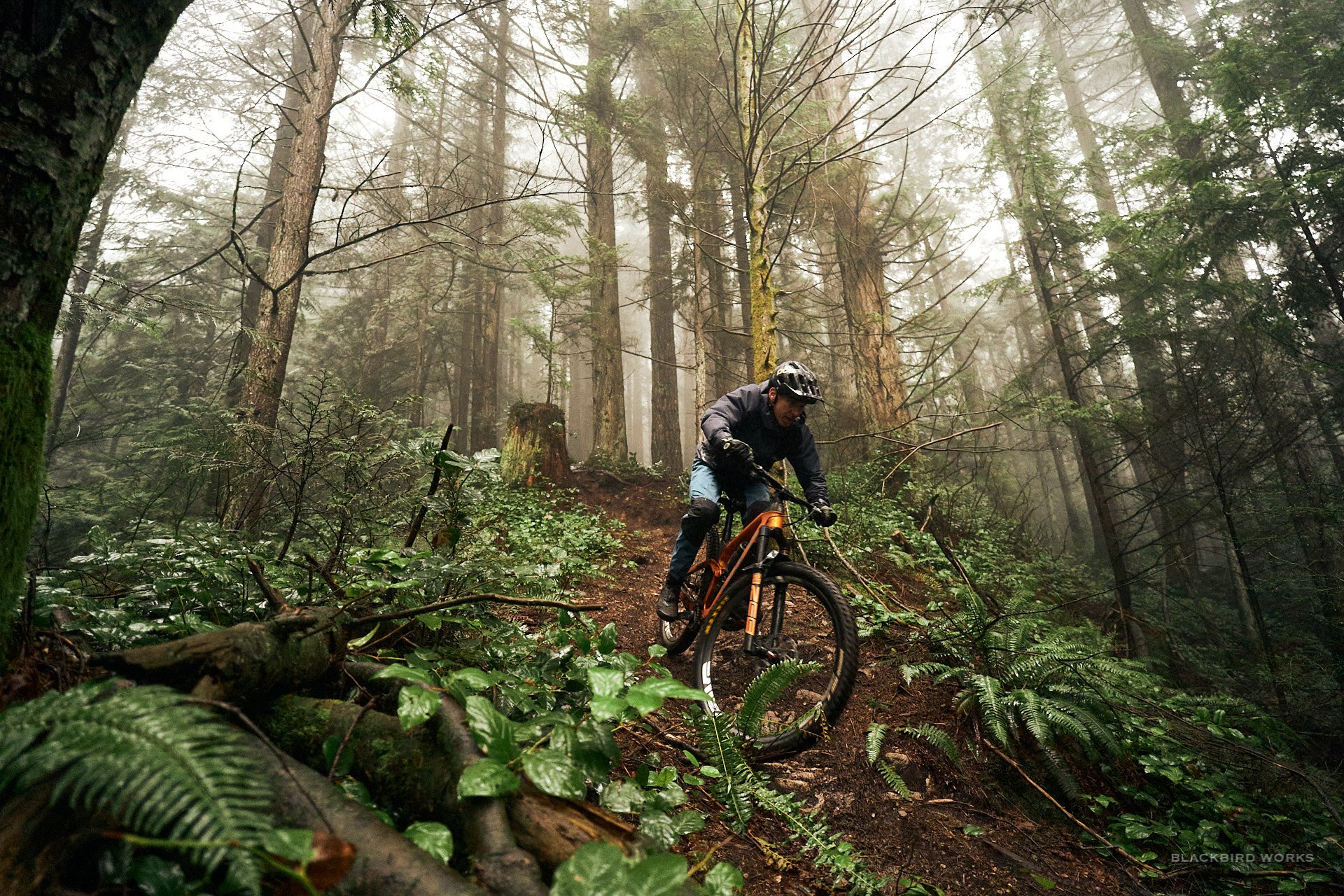
The solid feel and the outrageously low weight put Octa Mousse in a class of its own - although Super Mousse from Italy (which may be coming) appears similar on paper.
Despite the horrendous impact, my rim was not only intact, it remained round and dead true. The tire was going flat but wasn't completely there yet, which was the very least I expected. This was a moment I was waiting for with Octa Mousse because over several months it was my first and only flat. I let Mike lead and he pinned it pretty hard. I wasn't close enough to hound dog, but I kept him in sight for the rest of the trail, despite my rear flat. I had to be careful to weight my bars even more than usual in corners, because the rear tire would fold under excess pressure, but in a straight line I could stay on full gas. This confirmed my hope that these would work well as a ride flat solution. They don't have the cornering bite.of CushCore without air, but they are better in a straight line and much better than Tannus. The most important consideration is that they are good enough to allow me to leave my tube and tire levers at home. This is really what you want from an insert so you don't have to wear it home as a bandolier or carry a tube with a valve long enough to be pushed through the insert, which seems like a challenging proposition for Octa Mousse. I'm certain a front flat would be worse because of the cornering challenges.
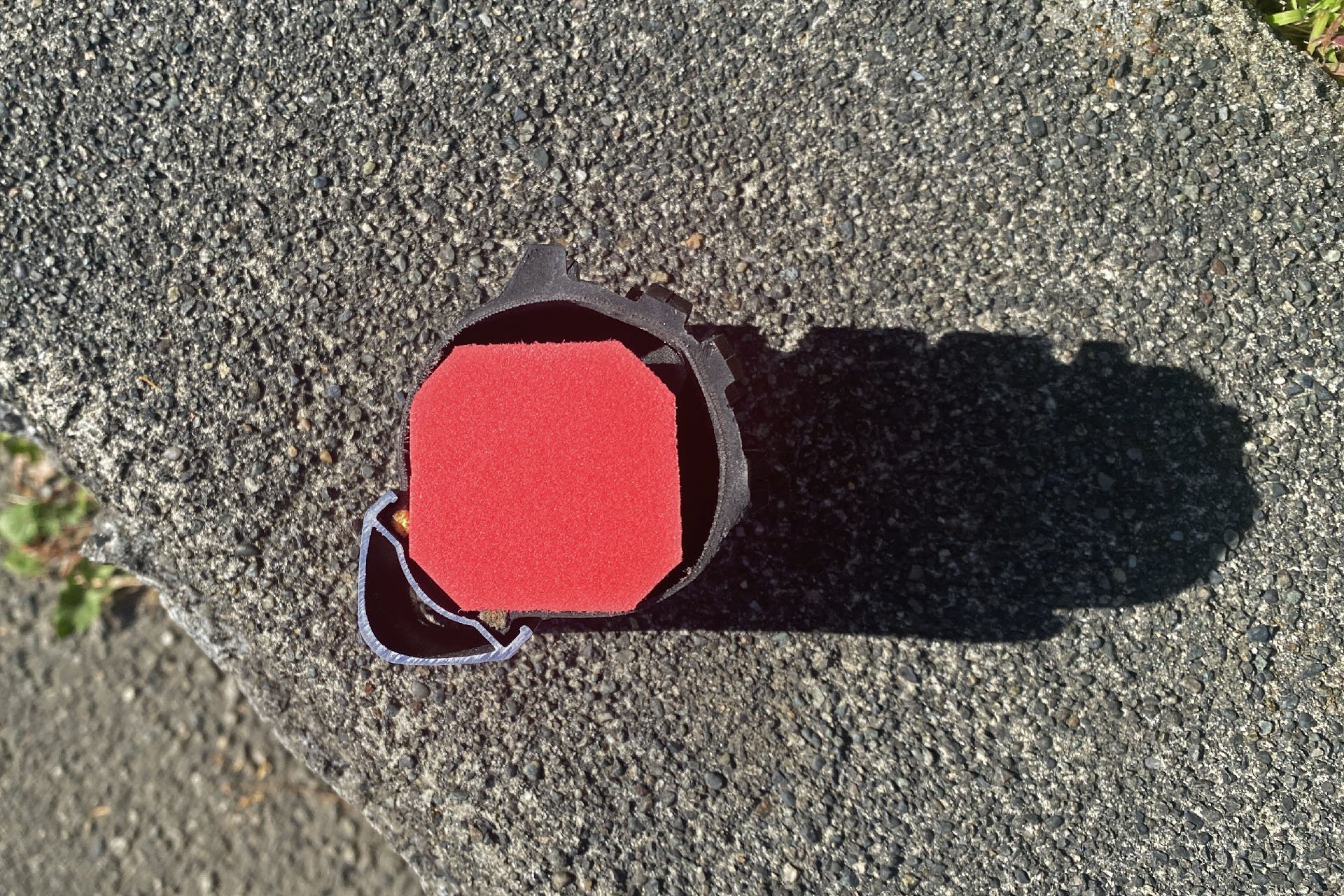
I believe these are Octa Mousse 45s mocked up with either a 2.2 or 2.3" tire, but I'm not entirely sure. I would have asked more questions, but my Spanish sucks. It's easy to see how little air volume remains to be filled. The rims have a 30mm inner width.
I had a very light Specialized Eliminator tire on the rear, which made the puncture even easier to explain, and once I peeled it off and inspected both the rim and the insert, there was no damage visible at all. Unlike CushCore and Tannus, a hard hit to an Octa Mousse-equipped wheel sometimes makes a noise that sounds like a rim strike on a conventional tubeless set up, and my very hard hit made a very loud noise. It's surprising that all that volume can be pushed through hard enough to make that sickening clacking sound without incurring any damage; it's almost like there is some voodoo going on.
I also spent some time on Octa Mousse 50s, which arrived after I'd been testing the 45s for a few weeks. Once again I received a red (light) and a charcoal (burlier) and I mounted them up to give them a try. I used them on similarly-sized tires as the 45s, so these were more appropriate, but in the end I wasn't sure I liked the larger size more. It certainly would be a better option for rim strikes or to ride flat, but the smaller air pocket didn't seem to have the same grip.

I believe these numbers are for 27.5 wheels because the readings on my scale were all 10-15 grams heavier.
As good as Octa Mousse is, I can imagine it being even better. If the bottom of the insert, the portion that sits within the rim and then rises up along the sidewall, was shaped more like CushCore or Tannus, and provided better sidewall support, it would be a world beater. The material itself, apart from being nice and light, also seems very tough. Unlike CushCore, there was no evidence of damage from hard hits, not even my violent rear wheel case. The material appears to have been extruded as a circular shape, or possibly a square, and then cut into the octagon. This process may not transfer well to a more complicated shape with curves and straight lines combined, but it's likely only a matter of time before someone cracks that code with a similar material.
The insert realm seems to be moving so fast it seems likely that even more impressive solutions are on the horizon. Every insert I have tried is made out of a material that differs greatly from all the others. This leads me to believe there are material options and manufacturing processes that haven't yet been tried in this application, and that will push down weight, improve function and durability, and hopefully make carrying a tube entirely optional.
You may want me to pick a favourite, but I don't think my favourite has been invented yet. I appreciate the weight, ride flat performance, and more robust trail feel of Octa Mousse as well as the rim protection and flat prevention, but the sidewall support of both Tannus and CushCore is superior, and their low pressure performance is more suited to nasty and wet winter conditions. The balanced attributes of Octa Mousse make them a very impressive entry to the market, and a product I plan to keep using on test bikes and my personal rigs.
Octa Mousse ships from Spain and each insert costs either €42 or €44. Octa Mousse also makes compatible valves.


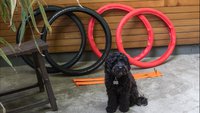
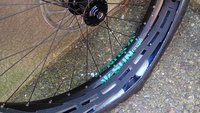







Comments
AndrewR
2 years, 10 months ago
@ Cam How does the "not slowing down as much through chunder/ jank rocks and roots" aspect of running an insert feel with the OM please?
I run Tannus Tubeless which I keep in the tyres for mainly this reason and as a back up "ride it out when flat" (as long as you are sensible) option. I haven't been able to significantly lower my air pressures with Tannus (21 instead of 22.5 psi on the front and 23 instead of 24.5 psi on the rear).
I am not that bothered about rim protection as I run WAO rims which will either a. survive almost anything and b. be replaced without question or delay if I do manage to break one.
WIth Cushcore XC I was (after recovering from my install hernia) able to run 20/ 22 psi and luckily did not need to test the run flat capabilities when they were fitted.
I feel that the Tannus do a better job of maintaining speed/ momentum than the Cushcore XC.
I have run Huck Norris (proto DH model) for a while and they offered nothing as far as lowering air pressure (maybe 0.5 psi if one was being imaginative), a little towards maintaining momentum but were good insurance against a hard rim strike.
If a normal tyre was given a mid range mark of 5/10 for maintaining speed/ momentum, then the Cushcore XC was a 7/10 and the Tannus Tubeless is 8.5/10 (I don't know what offers a higher mark but I am leaving the space there for the possibility).
Reply
fartymarty
2 years, 10 months ago
Andrew, what tyres sre you running with Tannus?
Reply
Cam McRae
2 years, 10 months ago
I would say that both Tannus and Cushcore are more capable in this instance, because of the larger volume of air that is outside the insert. The support comes on earlier using Octa Mousse because of this so the feeling is less 'deep' if you get my meaning. Damping is still easily felt but there is less of a cushion to resist deflection and roll easily over square edges.
Reply
Tjaard Breeuwer
2 years, 10 months ago
Oh you silly Pacific NorthWET riders, 2.8-3.0 isn’t a fatbike tire! Proper fatbikes have 4.6” tires and up! (Although there’s the diet-fatbikers who have 4.0”).
And champagne in a coupe (the glass shaped like cushcore)? What horror! If you want bubbles, why let them all out into the open? Champagne should go in a flute (the glass shaped like a roadie aero rim)🤣
Other than those sins, great review as always.
Reply
Cam McRae
2 years, 10 months ago
My gap there. Fat and Plus tires have dropped so far off my radar I put them into the same basket!
Reply
Cr4w
2 years, 10 months ago
I just ordered some OCT30 for my gravel bike.
Reply
sk8r
2 years, 10 months ago
Would like to hear what you think. I’ve been hoping Tannus would release something soon for gravel, but my local shop only has MTB inserts.
Reply
Cr4w
2 years, 10 months ago
The Cush Core Gravel seems too aggressive for the kind of riding I do with my gravel bike, relatively heavy. The OCT30 seem like a good balance. They're light enough that I may as well run them front and rear. I don't need run-flat capability, just a little extra support.
Reply
bigbrett
2 years, 10 months ago
Unrelated comment, only because you mentioned you are riding the Spesh eliminator......How are you liking it? I assume you are on the new T7/T9 version?
I'm particularly interested in comparing against a DHRII and aggressor. I live in Utah, so ride mostly loose-over-hard moondust and lots of slickrock when desert riding.
Unlike you north shore riders, wet is rare here, so my ideal rear tire is reasonably fast rolling, has maximum sidewall support and puncture resistance, and a durable rubber compound.
Only thing I've found that satisfies those requirements is Maxxis Aggressor in Dual Compound and DoubleDown casing.
The Aggressor is....fine....pretty adequate at everything but doesn't exceed either. Would rather run a DHRII or a Dissector out back, but Maxxis seems allergic to making any of their other tires in a DH/DD casings in harder rubber (dual compound), which sucks because it's very necessary when riding in the desert. I'll get maybe 10 rides out of a MaxxGrip tire in the rear before it starts to wear. Maybe 3-4x that with MaxxTerra.
This spesh tire looks like it could have some potential in the Grid Gravity casing. Would love to hear how you are getting along with it in the rear, and a comparison to it's Maxxis equivalents.
Reply
Cam McRae
2 years, 10 months ago
I was riding it during a stretch of dry weather and it was fine. Nothing particularly noteworthy about it for our riding. I had a light casing but I’ll have to check the compound and update this comment. It was only 900g. I may try to repair it but I haven’t yet.
Reply
Graham Driedger
2 years, 10 months ago
FYI, I'm currently running a (long inhale) DHR2 29 2.4 WT DD Maxxterra. Your prayers have been answered, and the SKU is TB00307900 .
Reply
Tim Coleman
2 years, 10 months ago
That's the Maxxis rear tire we've all been hoping for for ages! Now to try and find one!
Reply
bigbrett
2 years, 10 months ago
HAHAH thanks for the info! Yeah, I wish they made it in a dual compound but guess we can't all get what we want. MaxxTerra is better than MaxxGrip, thats for sure, but still will go through ~4 of them per season if run in the rear. I've managed to eek out a whole season on only two dual compound aggressors though!
Reply
AJ Barlas
2 years, 9 months ago
Hi Brett. Responding here as you requested in a PM. I don’t really have much to add to what Cam said regarding the tread – nothing noteworthy in the dry. I haven’t had much/any wet rides on it.
The gravity casing though has been quite impressive. It doesn’t feel any stiffer than the Super Gravity it replaced but it’s doing a far better job of protection. Even in slow wet winter conditions I was dinging the Hunt rim through the SG MM and had to stick an insert in to prevent further damage. But switching to the Eliminator when things dried stopped that, even at lower pressures and without inserts. It’s not wearing poorly but I haven’t ridden in conditions like you experience in Utah.
Reply
bigbrett
2 years, 9 months ago
Awesome AJ thanks so much for chiming in. Seems like it’s an aggressor that does a bit better in the loose. I’m keen on trying it! Maybe spesh finally has the rubber figured out
Reply
ShawMac
2 years, 10 months ago
Hmm, I was going to try Tannus based on the NSMB review, but now I am re-thinking that! Did you get dinged with a tariff charge when they were shipped to you?
Reply
Cam McRae
2 years, 10 months ago
I did not but shipping media samples often slips through or is paid for by the shipper. Aside from weight - if you go fir the red compound - the only advantage OM has over Tannus is rode flat performance. Both are excellent products imho.
Reply
ShawMac
2 years, 10 months ago
The run flat potential is a selling feature after having to walk out once because I couldn't get my valve core out. Although maybe if it is just a slow "get home" roll maybe Tannus still has enough protection.
I thought the special valve with the side output was interesting. It surprises me that a piece of foam like that would actually press hard enough to "plug" a regular vertical valve? Maybe it is the release of air rather than inflating that would be the issue.
Reply
IslandLife
2 years, 10 months ago
Check your inbox... just sent you a discount code for Tannus Tubeless.
Reply
zeedre
2 years, 10 months ago
Did they soak up sealant in any way?
Reply
Cam McRae
2 years, 10 months ago
Not at all that I noticed.
Reply
Kenny
2 years, 10 months ago
After trying tannus and a couple other foam inserts I still like nukeproof ARD the best. The right combo of light weight, support, and not too much install faff.
Reply
Cody Canning
2 years, 10 months ago
Cushcore is 1 min extra faff than regular tubeless if you understand and follow the install video. Weird how the main selling feature for pool noodle style inserts is install ease when the performance benefit is near zero vs running the correct casing at the correct pressure. At least Cushcore allows you to run a bit less pressure because of the firm sidewall support (tangible benefit). With these as soon as you drop pressure you are folding the tire around corners with your noodle slapping around inside your hoop waiting to save your fragile carbon rim from the next bottom out.
Reply
Cam McRae
2 years, 10 months ago
While the sidewall support is less evident than Tannus or Cushcore, it is certainly present and useful even at lower pressures. I have been struggling to figure out how this is accomplished and my best guess is that the large volume allows the insert to support the tire as a whole under cornering forces, rather than supporting directly at the sidewall (right or left) that is being subjected to corner stress. I am guessing that as the tire begins to roll, it is able to resist because the opposite side of the insert presses against the far sidewall, resisting deformation. Unlike Cushcore, this benefit diminishes greatly when you have a puncture, while straight line performance is undiminished, at least in the rear tire.
Is it Octamousse you've tried or a different one? If so, which model and size on what tire? Our experiences diverge significantly. I have no trouble installing Cushcore either so the install has little impact on my impressions. Cheers!
Reply
Cody Canning
2 years, 10 months ago
My experience is with Huck Norris and Vittoria Air Liner. Without something physically resisting folding it’s hard to imagine these are different, but if there is a real benefit and added support then cool. Even Cushcore XC has far worse ride feel and benefit than regular Cushcore as I tried to save some weight on my hardtail rig and quickly realized. I’m usually on 2.4-2.6 Maxxis WT stuff, depends on the bike and season.
Reply
Cam McRae
2 years, 10 months ago
I haven't tried Vittoria (apparently they are on the way) but I agree with your thoughts about Cushcore XC and Huck Norris. As mentioned above, it seems that folding is counteracted by the volume of Octa Mousse. I'm not certain that's what allows them to resist deflection in corners, but it's my best guess based on my experience. I would agree that in this regard Cushcore Pro is superior and for many, worth the weight penalty.
Reply
Michael
2 years, 9 months ago
I honestly don’t get the love for inserts… yet. I’ve now tried Tannus, Cushcore, FTD II and Rimpact all on a hardtail running either 27x2.6 and 2.8 and 29 x 2.6. In all cases they just made the bike feel more sluggish, heavier, less playful and the worst insult? Harsher… I’m baffled these are still a thing. Still I hope one day someone will come out with a version of these that is actually fun to ride. Maybe it’s these?…
Reply
Please log in to leave a comment.